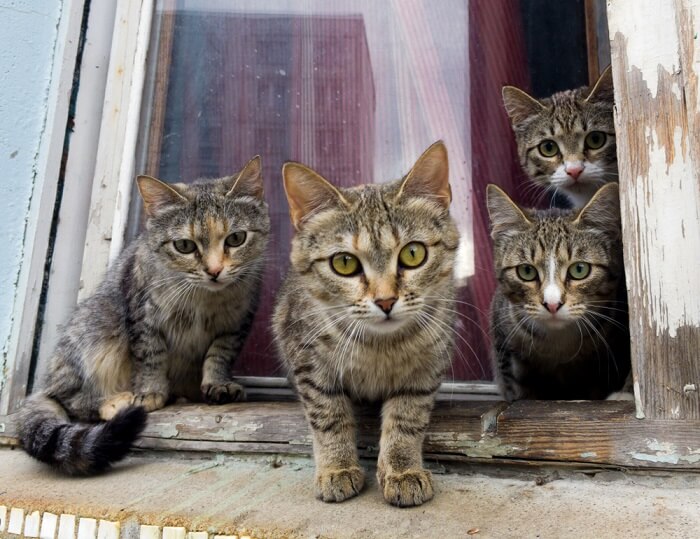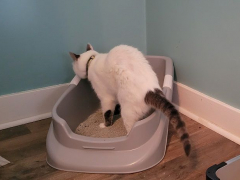
If you’ve acquired a new kitten, or have a female cat that recently produced a litter, one part of kitten care is knowing how to correctly determine their sex. Wondering if you have girl or boy kittens? It can be difficult to determine the sex of kittens, especially when they are very young, but this simple guide will offers expert tips to make it easier.
Kittens should be left unhandled for the first few weeks to bond with their mother and then handled only very carefully. The main assessment of gender is by visual assessment of the genitalia, with a careful physical exam if needed. Coat color and behavior can give some clues as to a kitten’s sex, but are much less reliable.Key Takeaways
How to Tell the Sex of a Kitten
There are a few easy steps to follow, including waiting for the right time, correct handling, and then visual and physical assessment of their genital region. Coat color can sometimes offer a clue (hello, torties!), but the best way is to look at the genitals. Females have a smaller gap between the anus and genital opening, and boy cats will have small testicles between their anus and penis. Ready to assess the sex of your kittens? Follow these steps:
Gentle Handling
In order to assess the sex of your kitten, you will need to handle it to observe its genitalia. Young kittens are fragile and easily stressed. Pick them up gently, remaining close to their littermates and mother, and hold them closely against you so that they feel more secure.
Scratching along their back to the base of the tail will hopefully trigger the responsive lifting of the kitten’s tail, allowing you to visualize their genitals without too much handling.
Visual Assessment of the Genitalia

A female kitten’s vulva is a vertical slit close to the anus (left); a male’s penis is lower, with the testicles in between the penis and anus (right).
Determining the gender of a kitten can usually be achieved through visual assessment of their rear end.
A female kitten’s genitals consist of the vertical slit of the vulva sitting close below the anus. The gap between the anus and vulva is small, and together they resemble an upside-down exclamation point or a small letter “i.”
A male kitten’s genitals consist of a pair of testicles below the anus, with the penis below these. The gap between the anus and genital opening is therefore larger in males, and the area looks more like a colon (:).
If you are finding it difficult to tell an individual kitten’s sex, it can be helpful to visually compare two kittens to each other, until you find two that look dissimilar, and by a close comparison of the two side-by-side it can become more obvious which are female kittens and which are tomcats.
Physical Assessment
Visual cues should be sufficient to sex kittens, but if they all look too similar to each other, gentle physical assessment may be necessary. Take a kitten that you think is a boy, and very carefully use your thumb and finger to palpate the scrotum, just under the anus.
On a male cat, you might be able to feel two small, oval lumps under the skin—these are the testes in the scrotum, which confirms that the kitten is male.
Coat Color
If you’re desperate to know the sex of kittens before they’re old enough to handle, their fur color might give some indication, although this is not a fully reliable method.
Tricolor cats, such as calico or tortoiseshell cats, are almost always female. This is because this color pattern is genetically sex-linked, determined by the chromosomes, and so only present in female cats. Less reliably, ginger or orange tabby cats are more likely to be male, with around 80% of this coat color being tomcats.
Behavior

Observing the behavior of kittens is not an accurate way of determining their sex.
Some cat owners and breeders are adamant that you can tell a cat’s gender from their behavior and personality traits. This can be fun to try but is definitely not a reliable method to tell the sex of a kitten. Males and female cats can both have individual personalities and clear character traits and determining sex by how friendly, loyal, or independent cats are is impossible.
However, adult male cats are highly territorial and more likely to roam. They might also urine spray to establish their territory and become aggressive toward intruders. Female cats will become sexually mature from around 4 to 5 months of age and come into regular estrus during the breeding season. This might involve behavioral changes such as calling, increased affection, rolling around on the floor, and urine spraying.
Preventing Unwanted Litters
If you have a mother cat that has recently given birth to a litter of kittens, it’s always exciting to find out what mix of genders you have! But the mother-kitten bond needs time to develop, and disrupting the flow of this important relationship can cause problems. Human handling of newborn kittens can lead to rejection from the queen, so try and be patient.
It is advisable to leave young kittens alone until they are at least 2 to 3 weeks of age before trying to determine the sex of the kittens.
Having a litter of kittens is a huge responsibility. Kittens become sexually mature from around 4 months of age, and can become pregnant from this time if successfully mated. Cats are seasonal breeders, and females will have multiple estrus cycles throughout the season (February to August in the Northern Hemisphere). With four to six kittens produced per litter, and the ability for multiple pregnancies, cats are prolific breeders.
Unless cats undergo a spay or neuter procedure, they can start producing litters of kittens from a very young age. They will even mate with their siblings if both are kept intact and together. If you have two or more kittens of opposite genders, speak to a veterinarian about neutering to prevent unwanted litters.
Final Thoughts
Newborn kittens should be left well alone to bond with their mother for the first few weeks. At that stage, they can be safely handled gently to assess their sex. Female kittens have a vulval opening which is a vertical slit, found just below the anus. Male kittens have a larger gap between the anus and the penis, with the scrotum in between.
Small testicles might be gently palpated in the scrotum. Coat color can also give some clues to a kitten’s sex, with tri-colored cats genetically determined to be female, and orange-haired cats more likely to be male. Sexual behaviors can begin from as early as 4 months of age, so responsible cat owners should consider neutering under the advice of a veterinarian if they have kittens of more than one sex.
Also Read: How To Take Care Of A Kitten: The Complete Guide
Frequently Asked Questions
How can you tell if my kitten is a boy or a girl?
The best way to determine gender in kittens is to look at their genitalia. In females, the vulva looks like a vertical slit and is directly below the anus. In males, the penis is rounded and is located further from the anus with the testicles in between.
Can you tell a kitten’s gender by its face?
It is commonly thought that male cats have fuller faces than the more delicate females, but the only definite way to assess a kitten’s sex is by visual assessment of their genitalia.
What do female kittens’ privates look like?
Female kittens have a vulva that looks like a small vertical slit. It is located directly below their anus. Their genital region, therefore, looks a little like the small letter "i."







